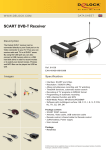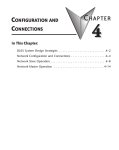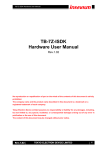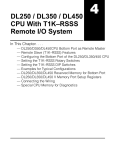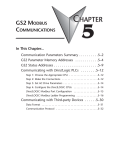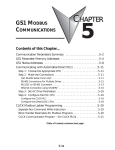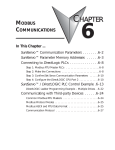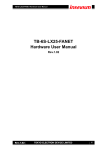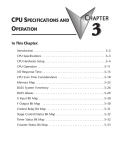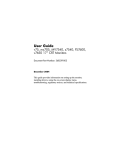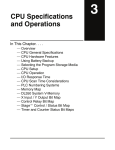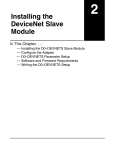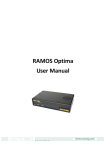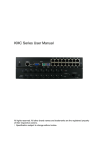Download App K_Intro to Serial Comm.qxd
Transcript
INTRODUCTION TO SERIAL COMMUNICATIONS A PPENDIX PPENDIX K In this Appendix Introduction to Serial Communications . . . . . . . . . . . . . . . . . . . . . .K–2 Appendix K: Introduction to Serial Communications 1 2 3 4 E 6 7 H 9 10 K 12 13 14 A B C D Introduction to Serial Communications DirectLOGIC® PLCs have two built-in serial communication ports which can be used to communicate to other PLCs or to other serial devices. In order to fully understand the capabilities and limitations of the serial ports, a brief introduction to serial communications is in order. There are three major components to any serial communications setup: Wiring standard Communications protocol Communications parameters Each of these will be discussed in more detail as they apply to DirectLOGIC PLCs. Wiring Standards K–2 There are three different wiring standards that can be used with most of the DirectLOGIC PLCs: RS-232C, RS-422 and RS-485. DL05 PLCs only support RS-232C, although RS-422 can be accomplished by using converters, such as the FA-ISOCON. RS-232C is a point-to-point wiring standard with a practical wiring distance of 15 meters, or 50 feet, maximum. This means that only two devices can communicate on an RS-232C network, a single master device and a single slave device, and the total cable length cannot exceed 50 feet. AutomationDirect L19772 cable (Belden® 8102), or equivalent, is recommended for RS-232C networks. Ports 1 and 2 on the DL05 use RJ12 phone type connectors (see pages 4-4 and 4-5 for the cable connections). DL05 Micro PLC User Manual, 6th Edition, Rev. C Appendix K: Introduction to Serial Communications Communications Protocols A communications protocol is the ‘language’ the devices on a network use to communicate with each other. All the devices on the network must use the same communications protocol in order to be able to communicate with each other. The protocols avaliable in the DirectLOGIC DL05 PLCs are listed in the following table. DL05 Communications Protocols Protocol Master Slave Port 1* Port 2 RS-232C RS-422 RS-485 K-Sequence DirectNET Modbus RTU ASCII No Yes Yes Out Yes Yes Yes In Yes Yes Yes No Yes Yes Yes Yes Yes Yes Yes Yes No Yes** Yes** Yes** No No No No * Port 1 supports slave only and is only RS-232C with fixed communications parameters of 9600 baud, 8 data bits, 1 start bit, 1 stop bit, odd parity and station address 1. It is an asynchronous, halfduplex DTE port and auto-selects between K-Sequence, DirectNET and Modbus RTU protocols. ** RS-422 is available on Port 2 using an RS-422 converter such as the FA-ISOCON. K-Sequence protocol is not available for use by a master DL05 PLC. Therefore, it cannot be used for networking between PLCs. Its primary use in the DL05 PLC is as a slave to DirectSOFT programming software and to an operator interface. DirectNET protocol is available for use by a master or by a slave DL05 PLC. This, and the fact that it is ‘native’ protocol, makes it ideal for PLC-to-PLC communication over a pointto-point or multipoint network using the RX and WX instructions. Modbus RTU protocol is a very common industry standard protocol, and can be used by a master or slave DL05 to communicate with a wide variety of industrial devices which support this protocol. ASCII is another very common industry standard protocol, and is commonly used where alpha-numeric character data is to be transferred. Many input devices, such as barcode readers and electronic scales, use ASCII protocol. Many output devices accept ASCII commands as well. No matter which wiring standard or protocol is used, there are several communications parameters to select for each device before it will be able to communicate. These parameters include: Baud Rate Flow Control Data Bits Echo Suppression Parity Timeouts Stop Bits Delay Times Station Address Format All of these parameters may not be necessary, or available, for your application. The parameters used will depend on the protocol being used and whether the device is a master or slave. NOTE: An important point to remember is that when the same parameter is available in the master and in the slave (i.e. Baud Rate, Parity, Stop Bits, etc), the settings must match. DL05 Micro PLC User Manual, 6th Edition, Rev. C 1 2 3 4 E 6 7 H 9 10 K 12 13 14 A B C D K–3 Appendix K: Introduction to Serial Communications 1 2 3 4 E 6 7 H 9 10 K 12 13 14 A B C D Communications Port 2 DL05 Port Specifications Communications Port 1 Connects to HPP, DirectSOFT 5, operator interfaces, etc. 6-pin, RS232C Communication speed (baud): 9600 (fixed) Parity: odd (fixed) Port 1 Station Address: 1 (fixed) 8 data bits 1 start, 1 stop bit Asynchronous, half-duplex, DTE Protocol (auto-select): K-sequence (slave only), DirectNET (slave only), Modbus RTU (slave only) K–4 Connects to HPP, DirectSOFT 5, operator interfaces, etc. 6-pin, multifunction port, RS232C, RS422, RS485 (RS485 with 2-wire is only available for Modbus and Non-sequence). Communication speed (baud): 300, 600, 1200, 2400, 4800, 9600, 19200, 38400 Parity: odd (default), even, none Port 2 Station Address: 1 (default) 8 data bits 1 start, 1 stop bit Asynchronous, half-duplex, DTE Protocol (auto-select): K-sequence (slave only), DirectNET (master/slave), Modbus RTU (master/slave), non-sequence/print Port 1 Pin Descriptions DL05 Port Pinouts 1 2 3 4 5 6 0V 5V RXD TXD 5V 0V Power (-) connection (GND) Power (+) connection Receive data (RS-232C) Transmit data (RS-232C) Power (+) connection Power (-) connection (GND) 1 Port 2 Pin Descriptions 1 0V 2 5V 3 TXD 4 RXD 5 RTS 6 CTS Power (-) connection (GND) Power (+) connection Transmit data (RS-232C) Receive data (RS-232C) Ready to send (RS-232C) Clear to send (RS232C) 1 Top View Note that the default configuration for port 2 is: Auto-detect among K-Sequence,DirectNET, and Modbus RTU protocols Timeout = Base Timeout x 1 (800 ms) RTS on delay time = 0 ms RTS off delay time = 0ms Station Number = 1 Baud rate = 19200 Stop bits = 1 Parity = odd Format = Hex DL05 Micro PLC User Manual, 6th Edition, Rev. C Appendix K: Introduction to Serial Communications Port Setup Using DirectSOFT or Ladder Logic Instructions Port 2 on the DL05 can be configured for communications using the various protocols which have been previously mentioned. Also, the communications parameters can be configured to match the parameters in the other device(s) with which the PLC will be communicating. The port may be configured using the DirectSOFT PLC programming software, or by using ladder logic within the PLC program. It is important to note that the settings for port 2 are never saved to disk with DirectSOFT, so if you are using port 2 in other than its default configuration it is a good idea to include the port setup in the ladder program, typically on a first scan bit, or in an initialization subroutine. To set up port 2 using DirectSOFT, the PLC must be turned on and connected to DirectSOFT. With the PLC Setup toolbar displayed, select the Port 2 button or select PLC > Setup > Setup Sec. Comm Port... from the menu bar located at the top of the programming window. A dialog box like the one below will appear. Make the appropriate settings and write them to the PLC. In order to set up port 2 in relay ladder logic the appropriate values must be written to V7655 (Word 1), V7656 (Word 2) and V7650 (Word 3, for ASCII only) to specify the settings for the port. Then write the ‘setup complete’ flag (K0500) to V7657 (Word 3) to request the CPU to accept the port settings. Once the CPU sees the ‘setup complete’ flag in V7657 it will test the port settings which have selected for validity, and then change the value in V7657 according to the results of this test. If the port settings are valid, the CPU will change the value in V7657 to 0A00 (‘A’ for Accepted). If there was an error in the port settings, the CPU will change the value in V7657 to 0E00 (‘E’ for Error). NOTE: This is a Helpful Hint. Rather than build the setup words manually from the tables, use DirectSOFT to set up the port as desired then use a Dataview to view the setup words as BCD/HEX. Then simply use these numbers in the setup code. The data that is written to the port setup words has two formats. The format that is used depends on whether K-Sequence, DirectNET, Modbus RTU (method 1) or ASCII (method 2) is selected. DL05 Micro PLC User Manual, 6th Edition, Rev. C 1 2 3 4 E 6 7 H 9 10 K 12 13 14 A B C D K–5 Appendix K: Introduction to Serial Communications Port 2 Setup for RLL Using K-Sequence, DirectNET or Modbus RTU 1 2 3 4 E 6 7 H 9 10 K 12 13 14 A B C D K–6 V7655 (Word 1) RTS On-delay Timeout (% of timeout) 0yyy 0ttt mmmm mxxx yyy 000 = 0ms 001 = 2ms 010 = 5ms 011 = 10ms 100 = 20ms 101 = 50ms 110 = 100ms 111 = 500ms ttt 000 = 100% 001 = 120% 010 = 150% 011 = 200% 100 = 500% 101 = 1000% 110 = 2000% 111 = 5000% V7656 (Word 2) Parity Stop Bits Baud Rate pp 00 = None 10 = Odd 11 = Even s 0 = 1 bit 1 = 2 bits bbb 000 = 300 001 = 600 010 = 1200 011 = 2400 100 = 4800 101 = 9600 110 = 19200 111 = 38400 V7656 (Word 2) cont’d Protocol Port 2 Address K-Sequence, DirectNET & Modbus RTU pps0 0bbb xaaa aaaa (DirectNET) DirectNET and Modbus RTU aaaaaaa DirectNET: 1-90 Modbus RTU: 1-247 K-Sequence, DirectNET & Modbus RTU pps0 0bbb xaaa aaaa x 0 = Hex 1 = ASCII DL05 Micro PLC User Manual, 6th Edition, Rev. C Protocol RTS Off-delay mmmmm 10000 = K-Sequence 01000 = DirectNET 00100 = Modbus RTU xxx 000 = 0ms 001 = 2ms 010 = 5ms 011 = 10ms 100 = 20ms 101 = 50ms 110 = 100ms 111 = 500ms Appendix K: Introduction to Serial Communications Use the ladder logic shown below to set up port 2 for Modbus protocol for the following: RTS On-delay of 10ms, Base timeout x1, RTS Off-delay of 5ms, Odd parity, 1 Stop bit, 19,200 baud or Station Number 23. SP0 LD K3022 OUT V7655 LD K8617 OUT V7656 Port 2 Setup for RLL Using ASCII V7655 (Word 1) RTS On-delay Timeout (in% of std. timeout) 0yyy 0ttt mmmm mxxx yyy 000 = 0ms 001 = 2ms 010 = 5ms 011 = 10ms 100 = 20ms 101 = 50ms 110 = 100ms 111 = 500ms ttt 000 = 100% 001 = 120% 010 = 150% 011 = 200% 100 = 500% 101 = 1000% 110 = 2000% 111 = 5000% Protocol RTS Off-delay mmmmm 00010 = Non-Sequence xxx 000 = 0ms 001 = 2ms 010 = 5ms 011 = 10ms 100 = 20ms 101 = 50ms 110 = 100ms 111 = 500ms V7656 (Word 2) Parity Stop Bits Baud Rate K-Sequence, DirectNET & Modbus RTU pps0 0bbb aaaa aaaa pp s bbb 00 = None 0 = 1 bit 000 = 300 10 = Odd 11 = Even 1 = 2 bits 001 = 600 010 = 1200 011 = 2400 100 = 4800 101 = 9600 110 = 19200 111 = 38400 DL05 Micro PLC User Manual, 6th Edition, Rev. C 1 2 3 4 E 6 7 H 9 10 K 12 13 14 A B C D K–7 Appendix K: Introduction to Serial Communications 1 2 3 4 E 6 7 H 9 10 K 12 13 14 A B C D K–8 V7656 (Word 2) cont’d K-Sequence, DirectNET & Modbus RTU Protocol Mode aaaaaaaa 01110000 = No flow control 01110001 = Xon/Xoff flow control 01110010 = RTS flow control 01110011 = Xon/Xoff and RTS flow control V7650 (Word 3) V-memory address for data Hex value of the V-memory location to temporarily store the ASCII data coming into the PLC. Set this parameter to an unused Vmemory location which has enough consecutive memory locations free to store the longest string that will come into the PLC. Use the ladder logic shown below to set up port 2 for Non-sequence (ASCII) communications with the following: RTS On-delay of 10ms, Base timeout x1, RTS Off-delay of 5ms, Odd parity, 1 Stop bit, 19,200 baud, 8 data bits, V-memory buffer starting at V2000 and no flow control. SP0 LD K3012 OUT V7655 LD K8670 OUT V7656 LDA O2000 OUT V7650 DL05 Micro PLC User Manual, 6th Edition, Rev. C Appendix K: Introduction to Serial Communications K-Sequence Communications The K-Sequence protocol can be used for communication with DirectSOFT, an operator interface or any other device that can be a K-Sequence master. The DL05 PLC can be a KSequence slave on either port 1 or port 2. The DL05 PLC cannot be a K-Sequence master. In order to use port 2 for K-Sequence communications you first need to set up the port using either DirectSOFT or ladder logic as previously described. DirectNET Communications The DirectNET protocol can be used to communicate to another PLC or to other devices that can use the DirectNET protocol. The DL05 can be used as either a master using port 2 or a slave using either port 1 or port 2. In order to use port 2 for DirectNET communications you must first setup the port using either DirectSOFT or ladder logic as previously described. For network slave operation, nothing more needs to be done. Port 2 will function as a slave unless network communications instructions are executed by the ladder logic program. For a network master operation you will simply need to add some ladder rungs using the network communication instructions RX and/or WX. Only one network communication instruction should be executed at any given time. If you have just a few network communications instructions in your program, you can use discrete bits to interlock them. If you are using many network communications instructions, a counter or a shift register will be a more convenient way to interlock the instructions. The following step-by-step procedure will provide the information necessary to set up your ladder program to receive data from a network slave. Step 1: Identify Master Port # and Slave # The first Load (LD) instruction identifies the communications port number on the network master (DL05) and the address of the slave station. This instruction can address up to 99 Modbus slaves, or 90 DirectNET slaves. The format of the word is shown to the right. The “F2” in the upper byte indicates the use of the the port on the right on the DL05 PLC, port number 2. The lower byte contains the slave address number in BCD (01 to 99). Step 2: Load Number of Bytes to Transfer The second Load (LD) instruction determines the number of bytes which will be transferred between the master and slave in the subsequent WX or RX instruction. The value to be loaded is in BCD format (decimal), from 1 to 128 bytes. F 2 0 1 Slave address (BCD) Port number (BCD) Internal port (hex) LD KF201 6 4 (BCD) # of bytes to transfer LD K64 DL05 Micro PLC User Manual, 6th Edition, Rev. C 1 2 3 4 E 6 7 H 9 10 K 12 13 14 A B C D K–9 Appendix K: Introduction to Serial Communications 1 2 3 4 E 6 7 H 9 10 K 12 13 14 A B C D The number of bytes specified also depends on the type of data you want to obtain. For example, the DL05 Input points can be accessed by V-memory locations or as X input locations. However, if you only want X0 – X27, you’ll have to use the X input data type because the V-memory locations can only be accessed in 2-byte increments. The following table shows the byte ranges for the various types of DirectLOGIC products. DL05 Memory Bits per unit Bytes V-memory T / C current value Inputs (X, SP) Outputs (Y, C, Stage, T/C bits) Scratch Pad Memory Diagnostic Status 16 16 8 2 2 1 8 1 8 8 1 1 Step 3: Specify Master Memory Area K–10 The third instruction in the RX or WX sequence is a Load Address (LDA) instruction. Its purpose is to load the starting address of the memory area to be transferred. Entered as an octal number, the LDA instruction converts it to hex and places the result in the accumulator. For a WX instruction, the DL05 CPU sends the number of bytes previously specified from its memory area beginning at the LDA address specified. For an RX instruction, the DL05 CPU reads the number of bytes previously specified from the slave, placing the received data into its memory area beginning at the LDA address specified. 4 0 6 0 0 (octal) Starting address of master transfer area LDA O40600 MSB V40600 LSB 0 15 MSB 15 V40601 LSB 0 NOTE: Since V-memory words are always 16 bits, you may not always use the whole word. For example, if you only specify 3 bytes and you are reading Y outputs from the slave, you will only get 24 bits of data. In this case, only the 8 least significant bits of the last word location will be modified. The remaining 8 bits are not affected. DL05 Micro PLC User Manual, 6th Edition, Rev. C Appendix K: Introduction to Serial Communications Step 4: Specify Slave Memory Area The last instruction in our sequence is the WX or RX instruction itself. Use WX to write to the slave, and RX to read from the slave. All four of our instructions are shown to the right. In the last instruction, you must specify the starting address and a valid data type for the slave. • DirectNET slaves – specify the same address in the WX and RX instruction as the slave’s native I/O address • Modbus DL05 slaves – specify the same address in the WX and RX instruction as the slave’s native I/O address SP116 LD KF201 LD K64 LDA O40600 RX Y0 DL05 Micro PLC User Manual, 6th Edition, Rev. C 1 2 3 4 E 6 7 H 9 10 K 12 13 14 A B C D K–11 Appendix K: Introduction to Serial Communications Communications from a Ladder Program 1 2 3 4 E 6 7 H 9 10 K 12 13 14 A B C D Typically network SP117 Y1 communications will last longer SET than 1 scan. The program must SP116 wait for the communications to LD KF201 finish before starting the next Port Communication Error transaction. LD Port Busy K0003 Port 2, which can be a master, has two Special Relay contacts LDA O40600 associated with it (see Appendix D for comm port special relays). RX One indicates “Port Y0 busy”(SP116), and the other indicates ”Port Communication Error”(SP117). The example above shows the use of these contacts for a network master that only reads a device (RX). The “Port Busy” bit is on while the PLC communicates with the slave. When the bit is off the program can initiate the next network request. The “Port Communication Error” bit turns on when the Interlocking Relay PLC has detected an error. Use of this bit is optional. SP116 C100 LD When used, it should be ahead of any network instruction KF201 boxes since the error bit is reset when an RX or WX instruction is executed. LD K0003 Multiple Read and Write Interlocks K–12 If you are using multiple reads and writes in the RLL program, you have to interlock the routines to make sure all the routines are executed. If you don’t use the interlocks, then the CPU will only execute the first routine. This is because each port can only handle one transaction at a time. In the example to the right, after the RX instruction is executed, C100 is set. When the port has finished the communication task, the second routine is executed and C100 is reset. If you’re using RLLPLUS Stage Programming, you can put each routine in a separate program stage to ensure proper execution and switch from stage to stage allowing only one of them to be active at a time. LDA O40600 Interlocking Relay SP116 C100 RX VY0 C100 SET LD KF201 LD K0003 LDA O40400 WX VY0 C100 RST DL05 Micro PLC User Manual, 6th Edition, Rev. C Appendix K: Introduction to Serial Communications Modbus RTU Communications The Modbus RTU protocol can be used for communication with any device that uses the Modbus RTU protocol. The protocol is very common and is probably the closest thing to an “industry standard” protocol in existence. The DL05 can be a Modbus RTU slave on either port 1 or port 2, and it can be a Modbus RTU master on port 2. In order to use port 2 for Modbus RTU communications you must first set up the port using either DirectSOFT or ladder logic as previously described. For network slave operation, nothing more needs to be done. Port 2 will function as a slave unless network communications instructions are executed by the ladder logic program. For network master operation the Modbus RTU network communication instructions MRX and/or MWX must be added to the ladder program. If more than one network communication instruction is used, the rungs need to be interlocked to ensure that only one communication instruction is executed at any given time. If only a few network communications instructions are used in your program, discrete bits can be used to interlock them. If many network communications instructions are used, either a counter or a shift register will be a more convenient way to interlock the instructions. DL05 Micro PLC User Manual, 6th Edition, Rev. C 1 2 3 4 E 6 7 H 9 10 K 12 13 14 A B C D K–13













